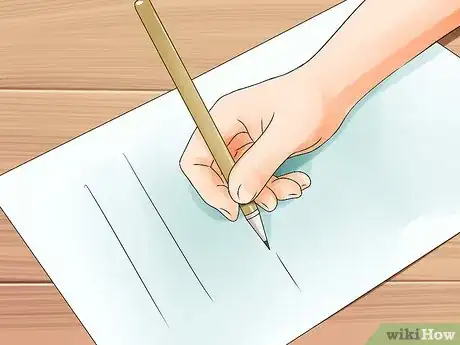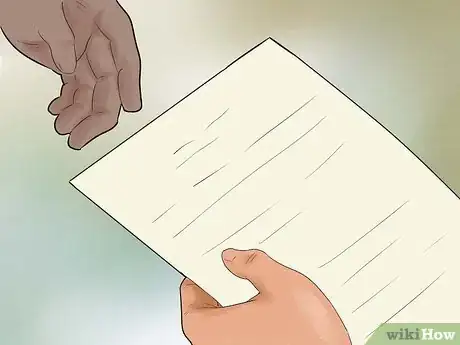This article was written by Jennifer Mueller, JD. Jennifer Mueller is an in-house legal expert at wikiHow. Jennifer reviews, fact-checks, and evaluates wikiHow's legal content to ensure thoroughness and accuracy. She received her JD from Indiana University Maurer School of Law in 2006.
There are 11 references cited in this article, which can be found at the bottom of the page.
This article has been viewed 53,612 times.
Although child custody normally is determined during the course of a divorce proceeding, there are other circumstances in which you would need to file a separate petition to establish custody of your child. Typically a petition for child custody would be used when there was no divorce proceeding because you were never married to the child's other parent. While specific procedures differ from state to state and even among courts within a state, the basic steps to file a petition for child custody are similar throughout the United States.[1]
Steps
Drafting Your Petition
-
1Find the right court. Since each court has its own rules regarding custody petitions, it's important to first identify the court where you'll be filing your petition.
- Typically you need to file in the county where the child lives. Keep in mind that in some counties you would use the county court of general jurisdiction, while others have a specific family court for divorce and child custody issues.
- If a court has already established paternity of the child pursuant to an order, or if you have another order granting child support, you typically must file your petition for child custody in that court.[2]
-
2Gather documentation. Depending on the context in which you're filing for custody, you may have to supply different types of documentation to the court along with your petition.
- You typically must have evidence that paternity for the child has been established. This would consist of either an affidavit acknowledging paternity that was signed by both parents when the child was born, a declaration of paternity filed by the father, or a court order declaring the man the legal father of the child.[3]
- You also will need the child's birth certificate, and copies of any other court orders such as a child support order that pertain to the child.[4]
- If you have not yet had paternity of your child established, you may first need to file a complaint to establish paternity. You typically can have the judge decide custody of the child in the same order that establishes paternity.[5]
Advertisement -
3Search for appropriate forms. Many courts have fill-in-the-blank forms you can use to file a petition for child custody.
- To find the forms you need, look on the court's website or go to the clerk's office of the court where you plan to file your petition. Legal aid offices or family law clinics also may have court-approved forms you can use.
- If there's no website for the particular court you're using, you may be able to find a self-help website for the entire state that has forms available. If you plan to use these forms, read the instructions carefully.[6]
- Keep in mind that state forms sometimes can't be used in certain counties. Additionally, some counties may have additional forms that must be included with your petition. The form's instructions typically will list any such differences or exceptions.
- Legal information websites such as FindLaw have links to forms related to child custody, child support, and parenting agreements available for each state.[7]
-
4Draft your petition. If you're using a prepared form, make sure you fill in all areas honestly and completely.
- If you were unable to find a form, you will have to format the petition yourself. Ask the clerk for copies of petitions filed in the same court in other cases that you can use as guides. Make sure you only copy the format of these sample petitions – you will have to adapt the language within the petition to fit your own case.
-
5Fill out any other required forms. Different courts have different forms that must accompany a petition for child custody.
- In some courts, the clerk will complete the summons that tells the other parent to appear in court; in others, you must fill out at least part of the summons and present it with your petition.[8] [9]
- If the court has not already ordered child support, you may be required to fill out additional forms to calculate child support. There also may be parental responsibilities worksheets that are required when you file a petition for custody.[10]
- If you've downloaded a packet of forms from the court, typically all required forms will be included in the packet along with instructions on how and when to fill out and file each document.[11]
- In some jurisdictions, you must fill out and file a notice of appearance if you plan to represent yourself in your custody proceedings. If you've hired an attorney, he or she will fill out and file an appearance.[12]
Filing Your Petition
-
1Sign your petition. In some jurisdictions, you may be required to sign your petition in the presence of a notary public.
- A petition or complaint requiring a notary's seal and signature typically is called a "verified" complaint. The notary verifies your identity by reviewing identification documents from you before you sign your court documents.[13] [14]
- Before you sign your petition, double-check the information you've included to make sure everything is true and correct to the best of your knowledge. You also should make sure you've included any other documents that are required to file the petition.
- Typically any affidavits you've included would have to be signed in front of a notary as well, since affidavits are signed under oath.[15]
-
2Take your paperwork to the clerk's office. The clerk of the court that will hear your case must file your petition and assign it a file number.
- You will need the originals and two copies of the documents. The first copy will be for your own records and the second will be for the other parent. The clerk will keep the originals for the court files.[16]
- The clerk will stamp your originals and copies "filed" and assign the case number. You must pay a filing fee to have these documents filed. This fee varies greatly among courts, so you may want to call the clerk's office before you file to find out how much you'll have to pay.
- Generally you can expect to pay between $100 and $300 to file your petition for child custody. If you cannot afford this fee, you can apply to have the fees waived. The clerk will have an application you must fill out and disclose details about your income and assets. If you qualify as low-income, the court will waive court costs for you.[17]
-
3Have the other parent served. Once you've filed your petition, the other parent must have notice that you've requested a custody determination from the court.
- The clerk will issue a summons for the other parent to appear in court. Typically you must pay a sheriff's deputy or court officer to hand-deliver the summons and petition to the other parent, although you may be able to use certified mail with returned receipt requested.[18]
- If the other parent is difficult to locate or seems to be avoiding service, the court may appoint a special process server to locate him or her and serve the papers.[19]
-
4File your proof of service. When your petition has been delivered to the other parent, you typically must file a document showing that he or she has notice of the case.
- If you've served the documents using certified mail, the return receipt can serve as your proof of service. This form typically must be attached to a court form in which you describe how the other parent was served and when service was completed.
- Keep in mind that it may take several months to get a final custody order, depending on the time of year and how busy the courts are.[20]
- The service forms required by your court may include an affidavit or other form that must be signed by the person who completed service.[21]
Preparing for Your Hearing
-
1Wait for an answer from the other parent. After the other parent is served, he or she typically has a period of time to file an answer to your petition.
- Most courts give the other parent between 20 and 30 days after he or she is served with your petition to file an answer to it.[22]
- If that deadline passes and the other parent hasn't responded, you typically will be entitled to a default judgment, which means the judge will approve whatever custody arrangements or parenting plan you've described in your petition.[23]
- In some courts, an initial hearing is scheduled rather than requiring a written response from the other parent. The clerk will let you know what your next step is. If an initial hearing is scheduled, you must attend or your petition will be dismissed.[24]
-
2Consider consulting an attorney. Although uncontested custody proceedings are generally simple enough to handle on your own, you may want to get legal representation if the other parent is contesting your petition, and especially if the other parent has hired an attorney.
- Most states view shared custody as in the best interests of the child. If you are seeking sole custody of your child, you will have the burden of convincing the court that this arrangement is actually in the best interests of your child. In such a situation, hiring an attorney may be the best way to accomplish your goal, particularly if the other parent has a history of violence or abuse.[25]
- If you're worried about being able to afford an attorney, consider checking with your nearest legal aid office to see if you qualify for services there. Many communities also have family law clinics or law school clinics where you may be able to receive free or reduced-fee assistance.
- If the other parent has a history of violence or abuse, you may be able to find additional resources at your nearest domestic violence shelter.
-
3Attend any required parenting classes. Some jurisdictions require parents filing for custody to successfully complete parenting classes dealing with aspects of legal custody and the best interests of the child.[26] [27]
- The clerk will have information about any required parental orientation classes or programs, and will provide you with a description of the requirements along with schedules and locations where you can take the classes when you file your petition.[28]
- These classes typically teach parents the ways children deal with divorced or separated parents, and how to avoid harming the children. You also will learn about your court's procedures in a custody case and how judges evaluate custody using the "best interests of the child" standard.[29]
-
4Participate in mediation. Many courts require parents in custody proceedings to attempt to arrive at an agreement regarding parenting time before a court hearing will be scheduled.
- If the other parent files an answer or appears at the initial hearing, the court may order mediation to discuss and agree on a parenting plan.[30]
- Keep in mind that generally it's in the best interests of both parents and your child to come to an agreement on a parenting plan rather than have one ordered by a judge. If you're able to come to an agreement through mediation, you have more control over the outcome and can devise a custody plan that works best for everyone involved.[31]
- In most cases, you still will have to go to court even if you come to an agreement through mediation, because a judge must approve the parenting plan that you and the other parent have proposed.[32] [33]
-
5Organize your evidence and information. If you and the other parent don't come to an agreement on custody arrangements, you must prepare for a court hearing on the matter.
- Keep in mind that the judge will decide custody based on the best interests of the child. Thus, you should prepare evidence that tends to show that the custody arrangement you've requested is in the best interests of your child.[34]
- Generally, you must be able to show that the child has a stable living environment with you, and that you are able to meet your child's basic needs. You also must demonstrate that you have a good relationship with your child and are able to provide your child with adequate emotional support and supervision.[35]
- In addition to any documentary evidence, you might consider calling witnesses, such as a religious leader or your child's teacher or coach, to testify on your behalf.
- You also must be prepared to testify on your own behalf. The judge will ask you questions related to your child, the other parent, and your petition for custody.[36]
References
- ↑ http://www.selfrepresent.mo.gov/page.jsp?id=38351
- ↑ http://www.selfrepresent.mo.gov/page.jsp?id=38351
- ↑ http://www.selfrepresent.mo.gov/page.jsp?id=38351
- ↑ http://www.selfrepresent.mo.gov/page.jsp?id=38351
- ↑ http://www.masslegalhelp.org/domestic-violence/wdwgfh7/file-for-custody
- ↑ http://www.selfrepresent.mo.gov/page.jsp?id=38351
- ↑ http://family.findlaw.com/child-custody/child-custody-forms-by-state.html
- ↑ http://www.masslegalhelp.org/domestic-violence/wdwgfh7/file-for-custody
- ↑ http://www.selfrepresent.mo.gov/page.jsp?id=38351
- ↑ https://www.courts.state.co.us/Forms/Forms_List.cfm?Form_Type_ID=15
- ↑ https://www.courts.state.co.us/Forms/Forms_List.cfm?Form_Type_ID=15
- ↑ http://www.pacourts.us/assets/files/setting-3966/file-3923.pdf?cb=e0a5f0
- ↑ http://www.pacourts.us/assets/files/setting-3966/file-3884.pdf?cb=b736f6
- ↑ http://courts.oregon.gov/ojd/docs/osca/cpsd/courtimprovement/familylaw/instructions3bver07.pdf
- ↑ http://courts.oregon.gov/ojd/docs/osca/cpsd/courtimprovement/familylaw/instructions3bver07.pdf
- ↑ http://www.selfrepresent.mo.gov/page.jsp?id=38351
- ↑ http://www.selfrepresent.mo.gov/page.jsp?id=38351
- ↑ http://www.selfrepresent.mo.gov/page.jsp?id=38351
- ↑ http://www.selfrepresent.mo.gov/page.jsp?id=38351
- ↑ http://www.masslegalhelp.org/domestic-violence/wdwgfh7/file-for-custody
- ↑ http://www.pacourts.us/learn/representing-yourself/custody-proceedings
- ↑ http://www.selfrepresent.mo.gov/page.jsp?id=38351
- ↑ http://www.selfrepresent.mo.gov/page.jsp?id=38351
- ↑ http://www.selfrepresent.mo.gov/page.jsp?id=38351
- ↑ http://www.selfrepresent.mo.gov/page.jsp?id=38351
- ↑ http://www.selfrepresent.mo.gov/page.jsp?id=38351
- ↑ http://www.illinoislegalaid.org/index.cfm?fuseaction=home.dsp_content&contentID=5005#q=10
- ↑ http://www.selfrepresent.mo.gov/page.jsp?id=38351
- ↑ http://www.illinoislegalaid.org/index.cfm?fuseaction=home.dsp_content&contentID=5005#q=10
- ↑ http://www.selfrepresent.mo.gov/page.jsp?id=38351
- ↑ http://www.selfrepresent.mo.gov/page.jsp?id=38351
- ↑ http://www.selfrepresent.mo.gov/page.jsp?id=38351
- ↑ http://www.illinoislegalaid.org/index.cfm?fuseaction=home.dsp_content&contentID=5005#q=5
- ↑ http://www.masslegalhelp.org/domestic-violence/wdwgfh7/how-does-judge-decide-custody
- ↑ http://www.masslegalhelp.org/domestic-violence/wdwgfh7/how-does-judge-decide-custody
- ↑ http://www.masslegalhelp.org/domestic-violence/wdwgfh7/how-does-judge-decide-custody









































































